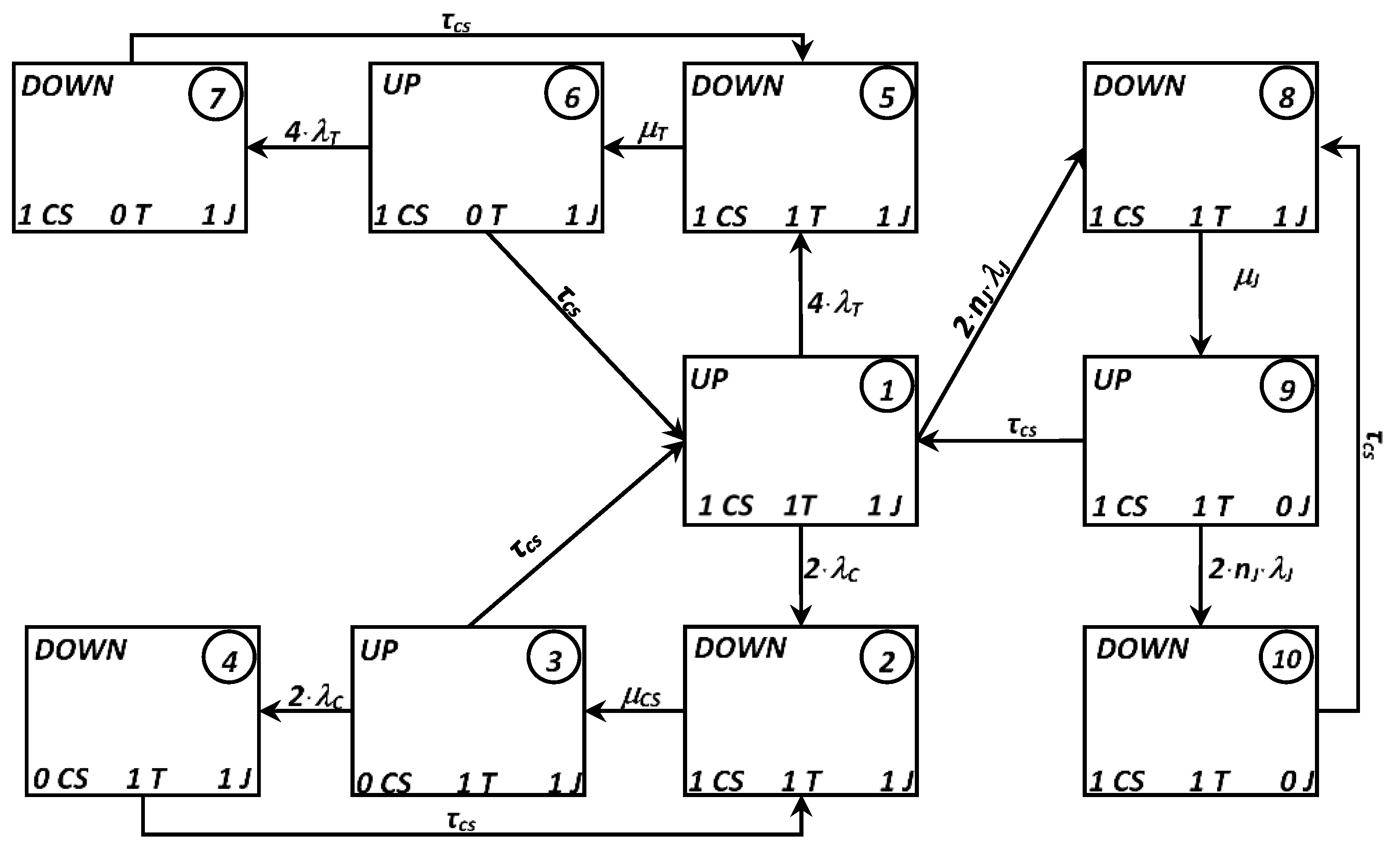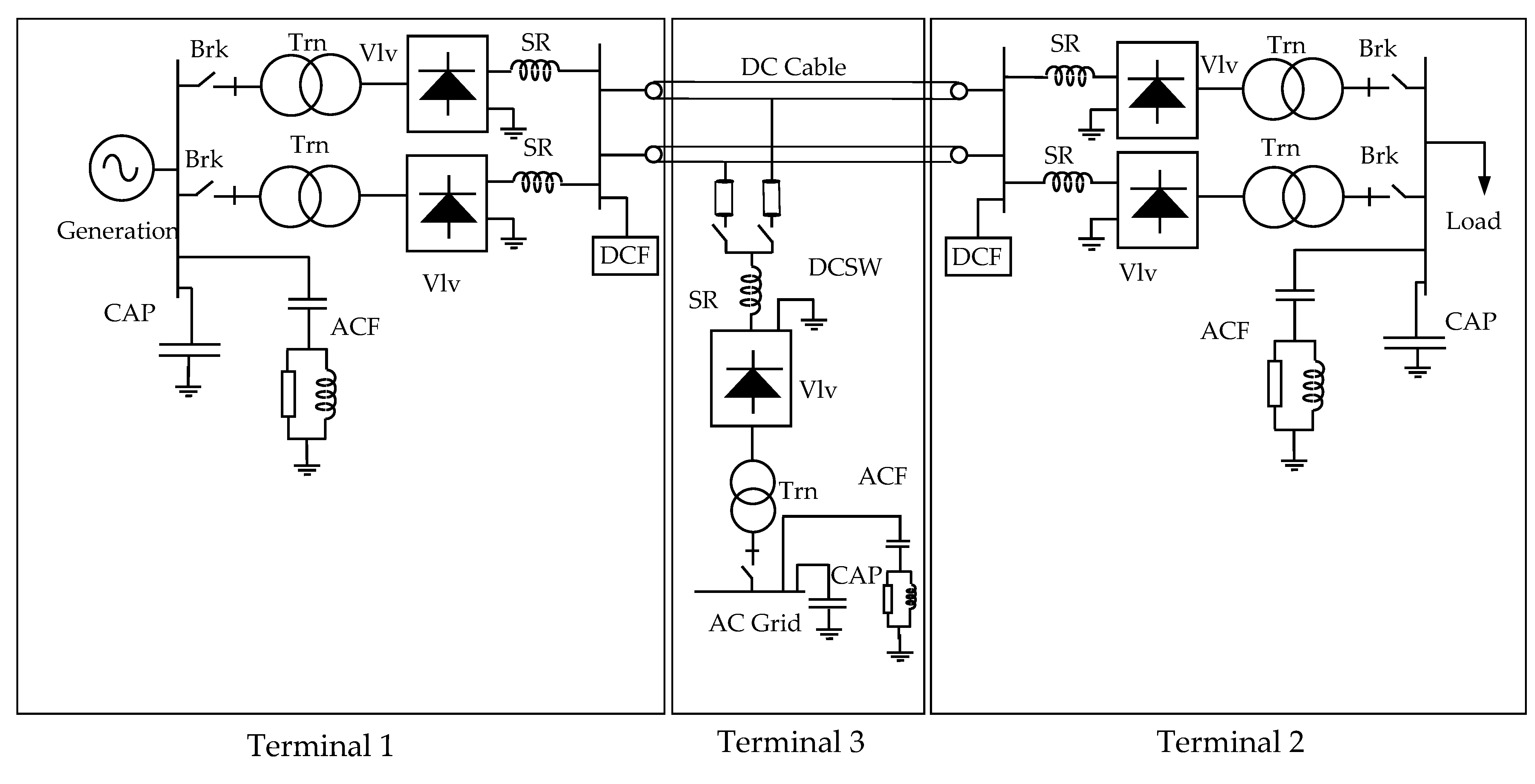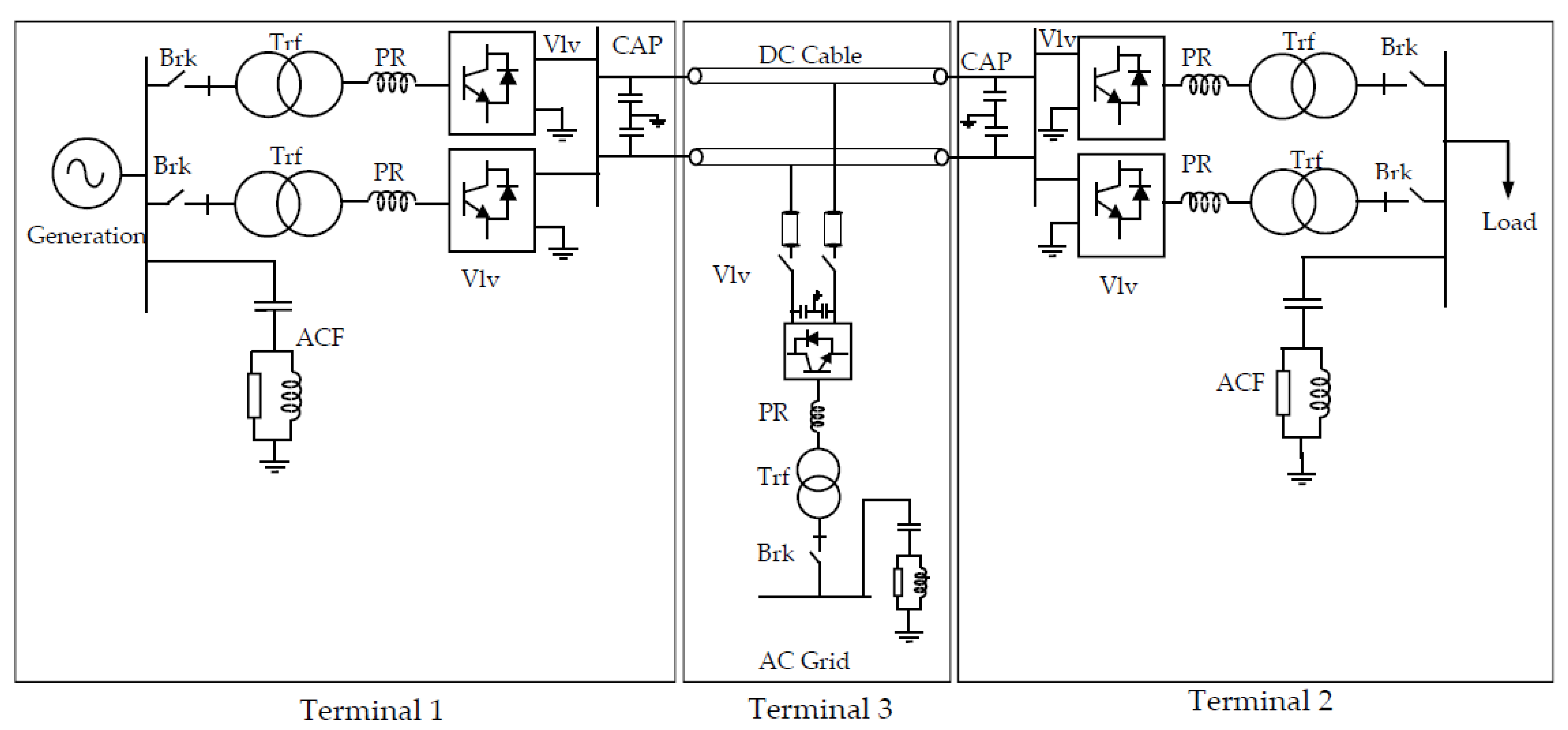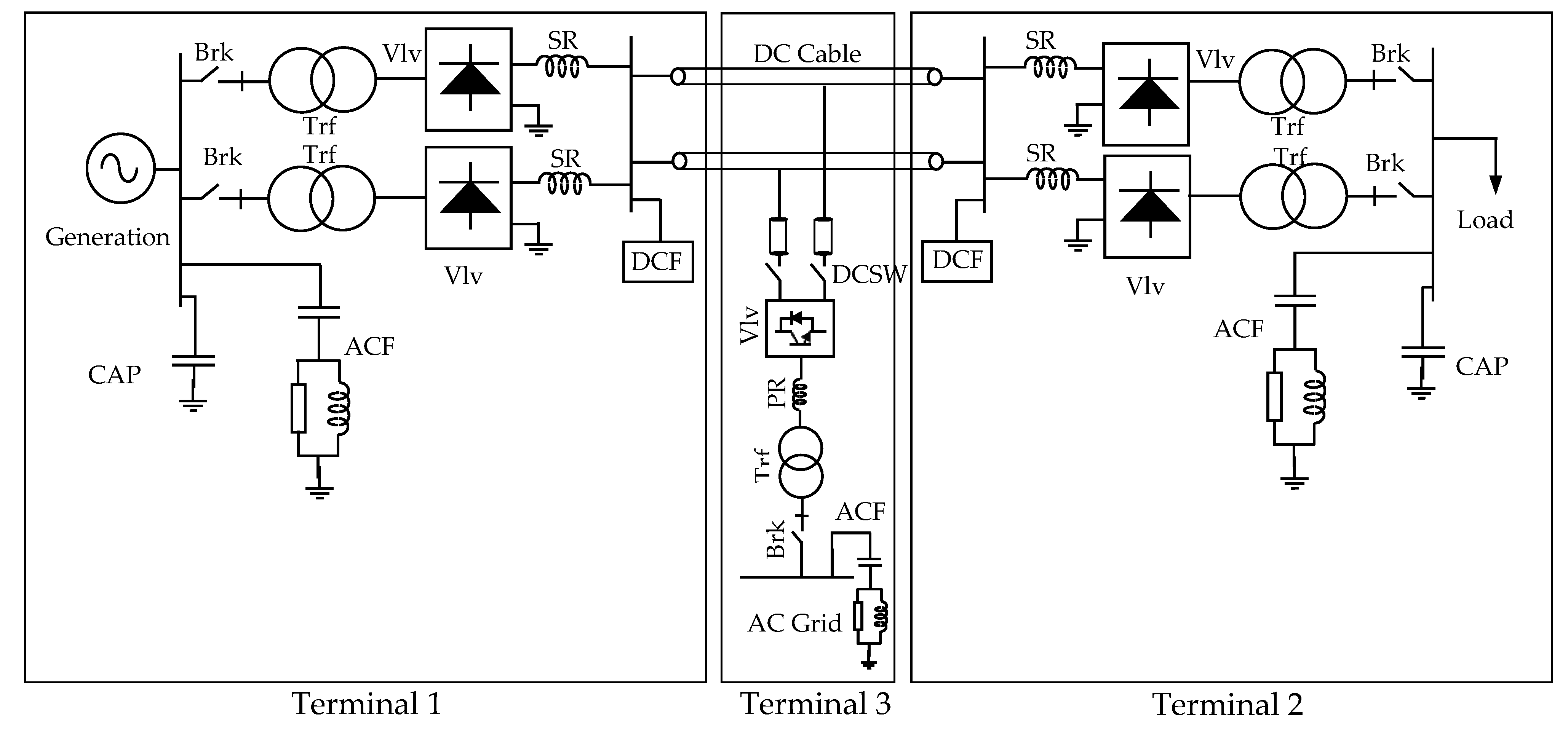Reliability Assessment of a Multi-State HVDC System by Combining Markov and Matrix-Based Methods
Abstract
1. Introduction
2. Materials and Methods
2.1. Matrix-Based System Reliability Approach
2.2. Case Studies and Availability Estimation Methods
3. Results
3.1. LCC-MTDC Analysis (Case Study One)
3.2. VSC-MTDC Analysis (Case Study Two)
3.3. MIXED-MTDC Analysis (Case Study Three)
3.4. MMC Effect (Case Study Four) and Summary of the Results
4. Conclusions
Author Contributions
Funding
Institutional Review Board Statement
Informed Consent Statement
Data Availability Statement
Conflicts of Interest
Abbreviations
| HVDC | High voltage direct current |
| MMC | Modular multilevel converters |
| MTDC | Multi-terminal direct current |
| VSC | Voltage-source converter |
| LCC | Line-commutated converter |
| SMs | Sub-modules |
| ACFs | AC filters |
| CAPs | Shunt capacitor banks |
| VSC CAPs | Shunt capacitor banks for VSC technology |
| Brks | AC breakers |
| Trns | Converter transformers |
| Vlvs | Valves |
| SRs | Smoothing reactors |
| PRs | Phase reactors |
| DCSWs | DC switches |
| DCFs | DC filters |
| VSC DCFs | DC filters for VSC technology |
| MSR | Matrix-based system reliability |
| τx | Time to resupply the component x [h/year] |
| λx | Failure rate of the component x [h/year] |
| T | One spare cable termination |
| CS | One spare cable span |
| J | One spare joint |
| µx | Mean time to repair of component x [h/year] |
| n | Number of spans of 1 cable |
| L | Length Of Each Cable [km] |
References
- Silva, B.; Moreira, C.L.; Seca, L.; Phulpin, Y.; Lopes, J.P. Provision of Inertial and Primary Frequency Control Services Using Offshore Multiterminal HVDC Networks. IEEE Trans. Sustain. Energy 2012, 3, 800–808. [Google Scholar] [CrossRef]
- Rink, Y.; Held, L.; Wenig, S.; Suriyah, M.; Leibfried, T. Utilization of MMC-HVDC for Primary and Secondary Control in Hybrid ACDC Power Systems. In Proceedings of the 53rd International Universities Power Engineering Conference, Glasgow, UK, 4–7 September 2018. [Google Scholar]
- Pierria, E.; Bindera, O.; Hemdanab, N.G.A.; Kurrata, M. Challenges and opportunities for a European HVDC grid. Renew. Sustain. Energy Rev. 2017, 70, 427–456. [Google Scholar] [CrossRef]
- Haileselassie, T.M.; Uhlen, K. Primary frequency control of remote grids connected by multi-terminal HVDC. In Proceedings of the IEEE PES General Meeting, Providence, RI, USA, 25–29 July 2010. [Google Scholar]
- Barnes, M.; van Hertem, D.; Teeuwsen, S.P.; Callavik, M. HVDC Systems in Smart Grids. Proc. IEEE 2017, 105, 2082–2098. [Google Scholar] [CrossRef]
- Benato, R.; Forzan, M.; Marelli, M.; Orini, A.; Zaccone, E. Harmonic behaviour of HVDC cables. Electr. Power Syst. Res. 2012, 89, 215–222. [Google Scholar] [CrossRef]
- Daryabak, M.; Filizadeh, S.; Jatskevich, J.; Davoudi, A.; Saeedifard, M.; Sood, V.K.; Martinez, J.A.; Aliprantis, D.; Mehrizi-Sani, J.C.E.A. Modeling of LCC-HVDC Systems Using Dynamic Phasors. IEEE Trans. Power Deliv. 2014, 29, 1989–1998. [Google Scholar] [CrossRef]
- Marquardt, R.; Lesnicar, A. New Concept for High Voltage-Modular Multilevel Converter. In Proceedings of the PESC 2004 Conference, Aachen, Germany, 20–25 June 2004. [Google Scholar]
- Westermann, D.; Van Hertem, D.; Real, G.; Rauhala, T.; Meisingset, M.; Kurrat, M.; Deppe, B.; Atmuri, R.; Küster, A.; Soerangr, D.; et al. Cigré Technical Brochure # 492. Voltage Source Converter (VSC) HVDC for Power Transmission—Economic Aspects and Comparison with Other AC and DC Technologies. 2012. Available online: https://www.semanticscholar.org/paper/Voltage-Source-Converter-(VSC)-HVDC-for-Power-andWestermann-Hertem/45b28196660499af79bf0fd27ca95f845e9fb6ff (accessed on 20 April 2021).
- Jacobson, B.; Karlsson, P.; Asplund, G.; Harnefors, L.; Jonsson, T. VSC-HVDC transmission with cascaded two-level converters. In Proc. of Cigré Session; CIGRE: Paris, France, 2010; pp. B4–B110. Available online: https://library.e.abb.com/public/422dcbc564d7a3e1c125781c00507e47/B4-110_2010%20-%20VSC-HVDC%20Transmission%20with%20Cascaded%20Two-level%20converters.pdf (accessed on 24 May 2021).
- Nami, A.; Liang, J.; Dijkhuizen, F.; Demetriades, G.D. Modular Multilevel Converters for HVDC Applications: Review on Converter Cells and Functionalities. IEEE Trans. Power Electron. 2014, 30, 18–36. [Google Scholar] [CrossRef]
- Benato, R.; Dambone Sessa, S.; de Zan, R.; Pazienza, M.; Rebolini, M. Italy-France Piemonte-Savoia HVDC Interconnection: An example of synergy between electric energy transmission and motorway transport. Proc. CIGRÉ 2018, 11, 2712–2720. [Google Scholar]
- Benato, R.; Chiarelli, A.; Sessa, S.D.; De Zan, R.; Rebolini, M.; Pazienza, M. HVDC Cables Along with Highway Infrastructures: The ‘Piedmont-Savoy’ Italy-France Intertie. In Proceedings of the 110th 2018 AEIT International Annual Conference, Bari, Italy, 3–5 October 2018. [Google Scholar]
- Benato, R.; Chiarelli, A.; Sessa, S.D.; De Zan, R.; Pazienza, M.; Rebolini, M. Piedmont-Savoy: The new interconnection between Italy and France with HVDC-VSC technology. An example of synergy between road infrastructures and power cables. L’energia Elettr. 2018, 95, 3–10. [Google Scholar]
- Benato, R.; Dambone Sessa, S.; Guizzo, R.; Rebolini, M. Synergy of the future: High voltage insulated power cables and railway-highway structures. IET Gener. Transm. Distrib. 2017, 11, 2712–2720. [Google Scholar] [CrossRef]
- Rinzo, G.; Pedrazzoli, G.; Chiarelli, A. HVDC Unsolved Issues: A Review. In Proceedings of the 2018 IEEE International Conference on Environment and Electrical Engineering and 2018 IEEE Industrial and Commercial Power Systems Europe (EEEIC/I&CPS Europe), Palermo, Italy, 12–15 June 2018; pp. 1–6. [Google Scholar]
- Benato, R.; Chiarelli, A.; Sessa, S.D. Transient overvoltage analysis in HVDC MMC power cables: Assessment of the critical points. In Proceedings of the 2019 AEIT HVDC International Conference, Florence, Italy, 9–10 May 2019. [Google Scholar]
- Cigre Technical Brochure # 496: Recommendations for Testing DC Extruded Cable Systems for Power Transmission at a Rated Voltage up to 500. 2012. Available online: https://e-cigre.org/publication/496-recommendations-for-testing-dc-extruded-cable-systems-for-power-transmission-at-a-rated-voltage-up-to-500-kv-this-tb-replaces-tb-219 (accessed on 20 April 2021).
- Billinton, R.; Allan, R.N. Reliability Evaluation of Engineering Systems, 2nd ed.; Springer Science Business Media: New York, NY, USA, 1992. [Google Scholar]
- Benato, R.; Napolitano, D. Reliability assessment of EHV gas-insulated transmission lines: Effect of redundancies. IEEE Trans. Power Deliv. 2008, 23, 2174–2181. [Google Scholar] [CrossRef]
- Benato, R.; Napolitano, D. State-space model for availability assessment of EHV OHL-UGC mixed power transmission link. Electr. Power Syst. Res. 2013, 99, 45–52. [Google Scholar] [CrossRef]
- Benato, R.; Napolitano, D. Overall cost comparison between cable and overhead lines including the costs for repair after random failures. IEEE Trans. Power Deliv. 2012, 27, 1213–1222. [Google Scholar] [CrossRef]
- Rausand, M.; Hoyland, A. System Reliability Theory: Models, Statistical Methods and Applications, 2nd ed.; John Wiley & Sons: Hoboken, NJ, USA, 2004. [Google Scholar]
- Benato, R.; Chiarelli, A.; Sessa, S.D.; Napolitano, D. Overall Availability Assessment of HVDC VSC XLPE Cable Symmetrical Monopolar Configuration. In Proceedings of the 2017 AEIT International Annual Conference, Cagliari, Italy, 20–22 September 2017. [Google Scholar]
- Benato, R.; Chiarelli, A.; Sessa, S.D.; Napolitano, D.; Rinzo, G. Valutazione della disponibilità di sistemi HVDC VSC monopolari simmetrici in cavo. L’energia Elettr. 2018, 95, 3–10. [Google Scholar]
- Billinton, R.; Li, W. Reliability Assessment of Electric Power Systems Using Monte Carlo Methods; Springer: New York, NY, USA, 1994. [Google Scholar]
- Rubisten, R.; Kroese, D. Simulation and the Monte Carlo Method; John Wiley & Sons: Hoboken, NJ, USA, 2017. [Google Scholar]
- Billinton, R.; Sankarakrishnan, A. A comparison of Montecarlo Simulation techniques for composite power system reliability assessment. In Proceedings of the IEEE WESCANEX 95 Conference on Communications, Power, and Computing, Winnipeg, Manitoba, 15–16 May 1995. [Google Scholar]
- Dambone Sessa, S.; Chiarelli, A.; L’abbate, A.; Benato, R. Availability Assessment Methods for HVDC Systems: A Review. In Proceedings of the 2019 AEIT HVDC International Conference (AEIT HVDC), Florence, Italy, 9–10 May 2019. [Google Scholar]
- Dambone Sessa, S.; Chiarelli, A.; Benato, R. Availability analysis of HVDC-VSC systems: A review. Energies 2019, 12, 2704. [Google Scholar] [CrossRef]
- Contreras-Jiménez, J.S.; Rivas-Dávalos, F.; Song, J.; Guardado, J.L. Multi-state system reliability analysis of HVDC transmission systems using matrix-based system reliability method. Int. J. Electr. Power Energy Syst. 2018, 100, 265–278. [Google Scholar] [CrossRef]
- Song, J.; Kang, W.H. System reliability and sensitivity under statistical dependence by matrix-based system reliability method. Struct. Saf. 2009, 31, 148–156. [Google Scholar] [CrossRef]
- Kang, W.H.; Song, J.; Gardoni, P. Matrix-based system reliability method and applications to bridge networks. Reliab. Eng. Syst. Saf. 2008, 93, 1584–1593. [Google Scholar] [CrossRef]
- Chiarelli, A. Reliability assessment of different HVDC technologies by means of Multi-State Matrix approach. In Proceedings of the 2020 IEEE International Conference on Environment and Electrical Engineering and 2020 IEEE Industrial and Commercial Power Systems Europe (EEEIC/I&CPS Europe), Madrid, Spain, 9–12 June 2020; pp. 1–6. [Google Scholar]
- Cigre Technical Brochure # 379: Update of Service Experience of HV Underground and Submarine Cable Systems. 2009. Available online: https://e-cigre.org/publication/379-update-of-service-experience-of-hv-underground-and-submarine-cable-systems (accessed on 20 April 2021).
- Worzyk, T. Submarine Power Cables: Design, Installation, Repair, Environmental Aspects, Power Systems; Springer Science + Business Media: Berlin, Germany, 2009. [Google Scholar]




| Component | Failure Rate (occ/year) | Mean Time to Repair (h) | Mean Time to Reinstall (h) | Availability Monte Carlo |
|---|---|---|---|---|
| ACF | 0.54 | 6 | 0 | 0.999630274 |
| CAP | 0.002 | 6 | 0 | 0.999998630 |
| VSC CAP | 0.0015 | 10 | 0 | 0.999998288 |
| DCF | 0.4 | 12 | 0 | 0.999452355 |
| VSC DCF | 0.001 | 5 | 0 | 0.999999429 |
| SR | 0.05 | 300 | 0 | 0.998290598 |
| PR | 0.14 | 24 | 0 | 0.999616585 |
| LCC CONVERTER | 1 | 5 | 0 | 0.999429549 |
| VSC CONVERTER | 0.5 | 4 | 0 | 0.999771742 |
| AC BREAKER | 0.015 | 50 | 0 | 0.999914391 |
| VSC AC BREAKER | 0.001 | 40 | 0 | 0.999995434 |
| DC BREAKER | 0.033 | 50 | 0 | 0.999811679 |
| DC SWITCH | 1 | 4 | 0 | 0.999543587 |
| DC CABLE (250 km) | 0.2495 | 720 | 0 | by considering only the cable failure rate: 0.979905231 by considering the failure rates of cable spans, terminations, and joints and their management: 0.960061242 |
| DC CABLE (200 km) | 0.1996 | 720 | 0 | by considering only the cable failure rate: 0.983859316 by considering the failure rates of cable spans, terminations, and joints, and their management: 0.967727545 |
| LCC TRANSFORMER | 0.07 | 1200 | 72 | 0.999424988 |
| VSC TRANSFORMER | 0.05 | 1000 | 48 | 0.999726102 |
| CENTRAL BUS | 0.11 | 50 | 0 | 0.999372540 |
| PROTECTION DEVICES | 0.003 | 20 | 0 | 0.999993151 |
| Case | 1st Terminal | 2nd Terminal | 3rd Terminal |
|---|---|---|---|
| 1 | (HVDC)-LCC | (HVDC)-LCC | (HVDC)-LCC |
| 2 | (HVDC)-VSC | (HVDC)-VSC | (HVDC)-VSC |
| 3 | (HVDC)-LCC | (HVDC)-LCC | (HVDC)-VSC |
| 4 | (HVDC)-MMC | (HVDC)-MMC | (HVDC)-MMC |
| Monte Carlo (By Considering Joints and Terminations) | Markov (1 Spare) τcs = 5 Months | Markov (3 Spares) τcs = 5 Months | Markov (1 Spare) τcs = 3 Months | Markov (3 Spares) τcs = 3 Months | Markov (1 Spare) τcs = 7 Months | Markov (3 Spares) τcs = 7 Months | |
|---|---|---|---|---|---|---|---|
| Availability | 0.960169250 | 0.929307760 | 0.959131820 | 0.948094450 | 0.960220020 | 0.904892290 | 0.955983320 |
| Unavailability (h/year) | 348.9 | 619.2 | 358 | 454.7 | 348.5 | 833.1 | 385.6 |
| State | Component Out | Capacity (p.u.) |
|---|---|---|
| 1 | All components are considered | 1.0 |
| 2 | Only one cap is considered | 0.9 |
| 3 | Only one DCF could be combined or not when the failure of one Cap is considered | 0.75 |
| 4 | Only one ACF is considered, which could be combined or not with the failure of one DCF | 0.65 |
| 5 | Two Caps are considered, which could be combined or not with the failure of one DCF | 0.62 |
| 6 | One Cap and one ACF are considered, which could be combined or not with the failure of one DCF | 0.6 |
| 7 | One or more components affecting a branch formed by AC-Brk, Trn, Vlvs, and/or a Cable line which could be combined or not with the failure of one Cap and/or the failure of One Cap and one ACF are considered | 0.5 |
| 8 | Two Caps and one ACF are considered, which could be combined or not with the failure of one DCF and/or with the failure of one or more components affecting a branch formed by AC-Brk, Trn, Vlvs, and/or Cable line | 0.3 |
| 9 | Other combinations are considered | 0 |
|
Transferred Power Capacity [pu] | Availability MSR (By Not Considering Joints and Terminations) | Availability MSR (By Considering Joints and Terminations) | Availability MSR & Markov (1 Spare) τcs = 5 Months |
|---|---|---|---|
| 1 | 0.838431777 | 0.836921414 | 0.734398449 |
| 0.95 | 0.000885806351 | 0.000883893503 | 0.000758777026 |
| 0.9 | 0.00000238229892 | 0.00000237879947 | 0.00000212945309 |
| 0.85 | 0.000598574247 | 0.000597281661 | 0.000512735529 |
| 0.82 | 1.51876215 × 10−12 | 1.51548247 × 10−12 | 1.30096361 × 10−12 |
| 0.8 | 0.00000000164009568 | 0.00000000163655399 | 0.00000000140489727 |
| 0.75 | 0.000953517617 | 0.000952116848 | 0.000852309524 |
| 0.7 | 0.0716220665 | 0.0722307951 | 0.11030195 |
| 0.65 | 0.000697349156 | 0.000696853214 | 0.000657587622 |
| 0.62 | 1.76942560 × 10−12 | 1.76816758 × 10−12 | 1.66855522 × 10−12 |
| 0.6 | 0.00000000191078458 | 0.00000000190942606 | 0.00000000180185568 |
| 0.5 | 0.0835876285 | 0.0844250210 | 0.142377211 |
| 0.3 | 1.43267368 × 10−15 | 1.43305281 × 10−15 | 1.45197815 × 10−15 |
| 0.2 | 0.00155131567 | 0.00158412007 | 0.00476723031 |
| 0 | 0.00166957954 | 0.00170612214 | 0.00537161837 |
| Transferred Power Capacity [pu] | Availability MSR (By Not Considering Joints and Terminations) | Availability MSR (By Considering Joints and Terminations) | Availability MSR & Markov (1 Spare) τcs = 5 months |
|---|---|---|---|
| 1 | 0.847195666 | 0.845669511 | 0.742074892 |
| 0.9 | 0.00000299777836 | 0.00000299338197 | 0.00000267999401 |
| 0.85 | 0.000605741633 | 0.000604433569 | 0.000518875073 |
| 0.82 | 2.40008070 × 10−12 | 2.39489786 × 10−12 | 2.05589641 × 10−12 |
| 0.8 | 0.00000000207406290 | 0.00000000206958408 | 0.00000000177663129 |
| 0.7 | 0.0687501958 | 0.0693701595 | 0.108161849 |
| 0.65 | 0.000698962649 | 0.000698470616 | 0.000659404429 |
| 0.62 | 2.76950414 × 10−12 | 2.76755512 × 10−12 | 2.61279252 × 10−12 |
| 0.6 | 0.00000000239330527 | 0.00000000239162100 | 0.00000000225788076 |
| 0.5 | 0.0795319491 | 0.08037035862 | 0.138426587 |
| 0.3 | 2.23184555 × 10−15 | 2.23243965 × 10−15 | 2.26212113 × 10−15 |
| 0.2 | 0.00155226264 | 0.00158526662 | 0.00478756778 |
| 0 | 0.00166222565 | 0.00169880291 | 0.00536814065 |
| Transferred Power Capacity [pu] | Availability MSR (By Not Considering Joints and Terminations) | Availability MSR (By Considering Joints and Terminations) | Availability MSR & Markov (1 Spare) τcs = 5 Months |
|---|---|---|---|
| 1 | 0.838431782 | 0.836921421 | 0.734398454 |
| 0.95 | 8.88112251 × 10−4 | 8.86194492 × 10−4 | 7.60752255 × 10−4 |
| 0.9 | 2.37653982 × 10−6 | 2.37305280 × 10−6 | 2.12451990 × 10−6 |
| 0.85 | 6.00132430 × 10−4 | 5.98836481 × 10−4 | 5.14070262 × 10−4 |
| 0.82 | 1.5227151 × 10−12 | 1.5194272 × 10−12 | 1.3043501 × 10−12 |
| 0.8 | 1.64436514 × 10−9 | 1.64081428 × 10−9 | 1.40855445 × 10−9 |
| 0.75 | 9.51213417 × 10−4 | 9.49817615 × 10−4 | 8.50335757 × 10−4 |
| 0.7 | 0.0718085110 | 0.0724188242 | 0.1105890851 |
| 0.65 | 6.95927172 × 10−4 | 6.95435771 × 10−4 | 6.56463821 × 10−4 |
| 0.62 | 1.76581445 × 10−12 | 1.76456873 × 10−12 | 1.66570124 × 10−12 |
| 0.6 | 1.906885143 × 10−9 | 1.905539101 × 10−9 | 1.798773712 × 10−9 |
| 0.5 | 0.0834010460 | 0.0842368528 | 0.142089863 |
| 0.3 | 1.42920245 × 10−15 | 1.42958323 × 10−15 | 1.44860712 × 10−15 |
| 0.2 | 0.0015553540 | 0.0015882438 | 0.00477964020 |
| 0 | 0.00166554121 | 0.00170199841 | 0.00535920841 |
| Transferred Power Capacity [pu] | Availability MSR (By Not Considering Joints and Terminations) | Availability MSR (By Considering Joints and Terminations) | Availability MSR & Markov (1 Spare) Τcs = 5 Months |
|---|---|---|---|
| 1 | 0.848452743 | 0.846924329 | 0.743176049 |
| 0.7 | 0.0688777605 | 0.0694988746 | 0.108362541 |
| 0.5 | 0.0795699558 | 0.0804088501 | 0.138502406 |
| 0.2 | 0.00149735393 | 0.00152982457 | 0.00469681485 |
| Technology | Availability MSR (By Not Considering Joints and Terminations) |
Availability MSR (By Considering Joints and Terminations) |
Availability MSR & Markov (1 Spare) τcs = 5 Months |
Unavailability MSR (By Not Considering Joints and Terminations) (h/Year) |
Unavailability MSR (By Considering Joints and Terminations) (h/Year) |
Unavailability MSR & Markov (h/Year) |
|---|---|---|---|---|---|---|
| HVDC LCC | 0.838431777 | 0.836921414 | 0.734398449 | 1415.3 | 1428.5 | 2326.6 |
| HVDC VSC | 0.847195666 | 0.845669511 | 0.742074892 | 1338.6 | 1351.9 | 2259.4 |
| HVDC MMC | 0.848452743 | 0.846924329 | 0.743176049 | 1327.5 | 1340.9 | 2249.8 |
| MIXED HVDC | 0.838431782 | 0.836921420 | 0.734398454 | 1415.3 | 1428.6 | 2326.7 |
Publisher’s Note: MDPI stays neutral with regard to jurisdictional claims in published maps and institutional affiliations. |
© 2021 by the authors. Licensee MDPI, Basel, Switzerland. This article is an open access article distributed under the terms and conditions of the Creative Commons Attribution (CC BY) license (https://creativecommons.org/licenses/by/4.0/).
Share and Cite
Benato, R.; Chiarelli, A.; Sessa, S.D. Reliability Assessment of a Multi-State HVDC System by Combining Markov and Matrix-Based Methods. Energies 2021, 14, 3097. https://doi.org/10.3390/en14113097
Benato R, Chiarelli A, Sessa SD. Reliability Assessment of a Multi-State HVDC System by Combining Markov and Matrix-Based Methods. Energies. 2021; 14(11):3097. https://doi.org/10.3390/en14113097
Chicago/Turabian StyleBenato, Roberto, Antonio Chiarelli, and Sebastian Dambone Sessa. 2021. "Reliability Assessment of a Multi-State HVDC System by Combining Markov and Matrix-Based Methods" Energies 14, no. 11: 3097. https://doi.org/10.3390/en14113097
APA StyleBenato, R., Chiarelli, A., & Sessa, S. D. (2021). Reliability Assessment of a Multi-State HVDC System by Combining Markov and Matrix-Based Methods. Energies, 14(11), 3097. https://doi.org/10.3390/en14113097








